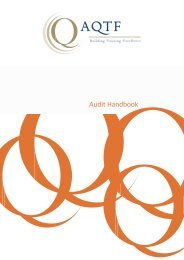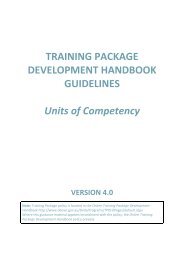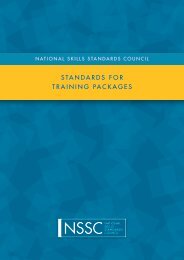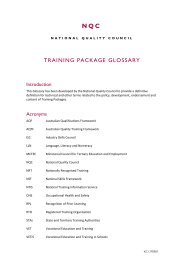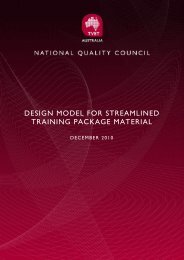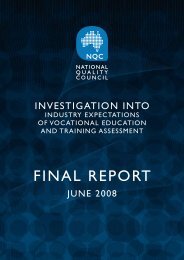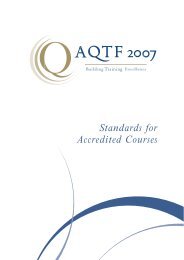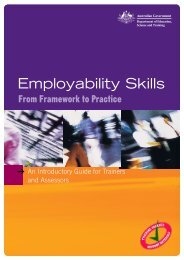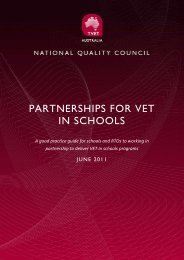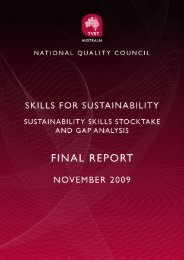VET Products for the 21st Century - National Skills Standards Council
VET Products for the 21st Century - National Skills Standards Council
VET Products for the 21st Century - National Skills Standards Council
Create successful ePaper yourself
Turn your PDF publications into a flip-book with our unique Google optimized e-Paper software.
5 . 6 N e w d e s i g n f o r T r a i n i n g P a c k a g e s a n d A c c r e d i t e dC o u r s e sPrevious NQC work and consultations havehighlighted stakeholder concerns regarding <strong>the</strong> sizeand complexity of <strong>National</strong> Training Packages in<strong>the</strong>ir current <strong>for</strong>m both in relation to <strong>the</strong> size ofsome units of competency and <strong>the</strong> amount andlevel of detail in supporting material and guidance<strong>for</strong> RTOs. Industry and enterprise groups have alsoexpressed concern that <strong>the</strong> development andcontinuous improvement process does notsufficiently engage enterprises due to its complexityand that <strong>National</strong> Training Packages in <strong>the</strong> current<strong>for</strong>m cannot be easily used by enterprises including<strong>for</strong> broader human resource processes (e.g. usingcompetency standards to create job profiles andcareer paths etc).Stakeholders want a more streamlined structureand less unnecessary detail. They also wantTraining Packages to be arranged in ways that are‘fit-<strong>for</strong>-purpose’ to <strong>the</strong> needs of particular groups.They especially want clarity to enable betterinterpretation of requirements.Simplifying <strong>the</strong> design of <strong>the</strong> Unit of Competency isconsidered a priority. It is suggested that <strong>the</strong> unit bestripped of most additional material which hasaccumulated over time and is advisory in nature,and moving this, where retention is warranted, too<strong>the</strong>r parts of <strong>the</strong> Training Package. This processcould also include consolidation of suchcomponents as range statements. In addition, <strong>the</strong>presentation of units (and <strong>the</strong>ir packaging asqualifications) should be in simple plain English tobetter engage industry practitioners in <strong>the</strong> TrainingPackage development and improvement processand to give providers a clear overview of <strong>the</strong>outcomes to be delivered. Those consulted alsosupport <strong>the</strong> fur<strong>the</strong>r consolidation of Units ofCompetency to eliminate duplication.There is also a desire <strong>for</strong> rationalising o<strong>the</strong>r units ofcompetency that are generic to many occupationsand industries. For example, units of competencythat relate to first aid, customer service skills, orcommunication skills that are required acrossindustries could be rationalised so that not everytraining package needs to provide its own particularunits of competency in <strong>the</strong>se areas. Onesuggestion is <strong>for</strong> Industry <strong>Skills</strong> <strong>Council</strong>s toexamine how best to retain relevance to specificindustries’ occupations and jobs while enablingindividuals to more readily ‘transport skills’ acrossoccupations. Ano<strong>the</strong>r suggestion is <strong>for</strong> a concertedef<strong>for</strong>t to identify in a systematic way those skills thatare similar in nature but applied to differentcontexts (<strong>for</strong> example, skills <strong>for</strong> process controlsystems, enterprise logistics, management andsupervision, and in<strong>for</strong>mation systems). It isimportant to note that ISCs have alreadycommenced work in this regard by assigningleadership <strong>for</strong> developing and maintaining particularsets of units that have cross industry application.It is felt that moving <strong>the</strong> preliminary in<strong>for</strong>mation willhelp to make <strong>the</strong> Training Packages moreaccessible. This includes in<strong>for</strong>mation regarding <strong>the</strong>vocational competence of <strong>the</strong> trainer, <strong>the</strong>development of <strong>the</strong> assessment tools, in<strong>for</strong>mationon recognition of prior learning, and o<strong>the</strong>r deliverystrategies. Never<strong>the</strong>less in<strong>for</strong>mants tell us thatmuch of <strong>the</strong> material currently in Training Packageswhich is regarded as duplicative or advisory shouldremain available even if presented separately or indifferent <strong>for</strong>mats.Ano<strong>the</strong>r desired simplification relates to <strong>the</strong>accessibility and inclusiveness of language used inTraining Packages. Participants want to ensure thatjargon free plain English is used and that it isworkplace friendly. This is felt to aid interpretation,as well as understanding, <strong>for</strong> employers andpractitioners alike. Many feel that it is important toimprove <strong>the</strong> accessibility of <strong>the</strong> Training Packagecontent. This includes a re-arrangement to suit <strong>the</strong>needs of different audiences or users, so thatemployers, RTOs, and individuals will be able toquickly find <strong>the</strong> in<strong>for</strong>mation that pertains to <strong>the</strong>m.There is considerable (but not unanimous) support<strong>for</strong> separating per<strong>for</strong>mance standards fromguidance and supporting in<strong>for</strong>mation <strong>for</strong> RTOs.Participants in favour of such separation believethat it would reduce <strong>the</strong> bulkiness of TrainingPackages and streamline in<strong>for</strong>mation to make itmore relevant <strong>for</strong> particular users and groups.Having <strong>the</strong> guidance documents as separatevolumes is also felt to enable <strong>the</strong> provision of muchmore specific in<strong>for</strong>mation. Supporters also believethat because Training Packages are in on-line<strong>for</strong>mats it would be easy to provide guidancein<strong>for</strong>mation via links within <strong>the</strong> unit of competencyitself. There is also a case <strong>for</strong> re-designing <strong>the</strong> online<strong>for</strong>mats <strong>the</strong>mselves through <strong>the</strong> opportunitycurrently available in <strong>the</strong> re-development of <strong>the</strong>national register (training.gov.au).O<strong>the</strong>r views provided suggest rearrangingin<strong>for</strong>mation into short <strong>for</strong>m or comprehensivevolumes according to requirements of differentaudiences (employers, RTOs, and learners). Theresource implications of such an approach arepotentially considerable.There was also overwhelming support <strong>for</strong> TrainingPackages to have <strong>the</strong> ability to incorporate <strong>the</strong><strong>VET</strong> PRODUCTS FOR THE 21 ST CENTURY - 18



